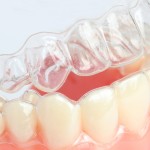
Following orthodontic treatment almost every patient will require a period of retention without which there is a tendency for teeth to return to their initial position. The aim of this trial was to compare three different retention methods.
Patient s completing a first course of orthodontic treatment were randomized into three retention methods: vacuum-formed retainer in the maxilla and bonded canine-to-canine retainer in the mandible (group V-CTC , n= 25), vacuum-formed retainer in the maxilla combined with stripping of the 10 proximal surfaces of the lower mandibular anterior teeth (group V-S, n=25) and prefabricated positioner covering the teeth in the maxilla and the mandible (group P, n=25). All retention devices were provided within one hour of debonding. Dental casts were taken before treatment; at appliance removal and at 12 and 24months of retention. Little′s irregularity index (LII), intercanine width, intermolar width, arch length, overjet, overbite and body height growth were recorded.
At 24 months there were 6 drop outs (1 in group V-CTC, 2 in group V-S and 3 in group P. 38 participants were considered to have cooperated excellently and 31 were judged to cooperate well with the retention regimen.
While some statistically significant differences were identified in some of the measurements these were not considered to be clinically important. All three retention methods after 2 years of retention had a good and successful capacity to retain the orthodontic treatment results.
The authors concluded
All 3 types of retention methods were equally effective in controlling relapse to a clinically acceptable level. The major part of relapse took place during the 1st year of retention while small or negligible changes were found during the 2nd year.
Comment.
We looked at a trial comparing Hawley and clear overlay retainers following orthodontic treatment back in 2011 (Dental Elf Nov 2nd 2011) that also found no statistical difference between the two approaches. The 2009 Cochrane review by Littlewood et al only included 5 trials and found that there was: –
insufficient research data on which to base our clinical practice on retention at present. There is an urgent need for high quality randomised controlled trials in this crucial area of orthodontic practice.
Links
Edman Tynelius G, Bondemark L, Lilja-Karlander E. A randomized controlled trial of three orthodontic retention methods in Class I four premolar extraction cases – stability after 2 years in retention. Orthod Craniofac Res. 2013 Jan 3. doi: 10.1111/ocr.12011. [Epub ahead of print] PubMed PMID: 23324112.
Littlewood SJ, Millett DT, Doubleday B, Bearn DR, Worthington HV. Retention procedures for stabilising tooth position after treatment with orthodontic braces. Cochrane Database of Systematic Reviews 2006, Issue 1. Art. No.: CD002283. DOI: 10.1002/14651858.CD002283.pub3.

[…] Dental Elf – 22nd Jan 2013 – Trial found little difference between three post orthodontic re… […]